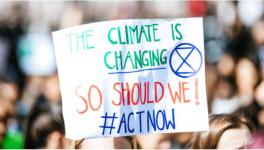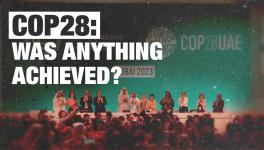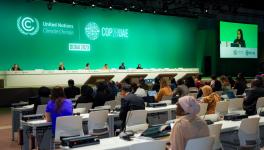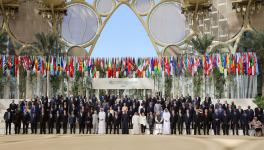Only a Thin Sliver of Hope-in-Hagen
The Copenhagen Accord, a political text of an agreement in Copenhagen, has been hammered out in a late meeting between Obama and the leaders of the BASIC – China, India South Africa and Brazil. It remains to be seen whether this will pass the 192 nations gathered there. If it does, it will at least not end in a complete fiasco and will retain just a slim chance of saving the world. The battle for preserving the structure of Kyoto, the rich countries accepting deep and immediate cuts, providing technology and finance, will continue as we move towards actualising the accord to a legally binding form.
The text accepts the target of remaining below 2 Deg C temperature rise, puts down some figures for Annex 1 countries, and promises finances starting with about $30 billion from 2012 and going up to $100 billion by 2020. The desperate attempts by the US, EU, Japan, Canada and others to jettison Kyoto and erase the difference between the rich countries and developing countries, did not succeed. The legally binding agreement is now postponed to 2010, giving some breathing space.
The flip side is that it is clear from the leaked UNFCC Note that this accord is not enough to limit the temperature rise to 2 Deg C. The commitments in the accord fall well below the required level of cuts, with the rich, industrialised countries cuts being even lower than that of the developing countries.
Why are countries such as China and India opposing a common set of cuts for all and insisting that Annex I countries need to make binding here and now? The moral position on this is unambiguous. What is melting the Arctic, Antarctic and Greenland ice fields is carbon that the Annex I countries have put in the atmosphere. If we consider a carbon budget for countries, the rich countries have already exhausted their budget and drawing on the budget of other countries. Fully 75% of the global accumulated carbon dioxide in the atmosphere is from countries that have only a 20% of the world’s population. This is the basis of the developing countries demand and the crucial phrase in Kyoto Protocol “common but differentiated” responsibility.
In order to break the unity of the developing countries, the US, EU and other rich countries want to separate the emerging countries from the others. That is why Hilary Clinton’s call of providing annual $100 billion as financial transfers to the less developed countries by 2020 provided China, India and other emerging economies also accept binding cuts. The attempt was to erase all notions of historical responsibility. If the rich countries can also get away with low cuts now, they can then take the position of “every country must reduce based on current emissions” in the future. In their game of how to retain and capture additional carbon space, putting all countries in a common basket is a huge advantage. For this, they were willing to take climate change negotiations and implicitly the world to the brink. This was the game being played out in Copenhagen.
The poorest developing nations have pressed for a 1.5 Deg C target but also put the developed countries on the mat. The weak emission cut targets makes clear that the developing countries are at a huge risk and will bear the main brunt of global warming. If the UNFCC leaked document is anything to go by, there is a serious mismatch between the cuts being discussed and even the figure of 2 Deg C that everybody claims to profess. Unfortunately, some of the developing countries focussed too much on 1.5 Deg C as the target and not 2 Deg C and lost sight of the crucial issue: the cuts being committed.
China responded to the US proposal -- linking financial transfers to emerging economies accepting binding commitments -- by offers of transparency and better national communications. A binding commitment is what India has also made clear it will not agree to at this stage of development.
One problem that India seemed to be have had in this negotiations was unwillingness to make stiff demands of the rich countries. It may be because of the strategic relationship it wants with the US or it may also be fear that making strong demands opens India out to also making binding commitments. Be that as it may, the focus on only what India will not do and asking for larger financial transfers was a rather negative way to engage with the climate change negotiations. It neither wins brownie points in trying to save the globe nor does it give India any specific advantage of staying out of binding commitments. But we must note that India did not break ranks with the developing countries as was feared after Jairam Ramesh’s many flip flops on the negotiations.
Too many leaders had gathered in Copenhagen to have it end in a complete failure. Though the accord was a face saving device for them, it does retain global warming and climate change as an agenda for all of us in the future. A complete failure might have killed all hope of a future binding agreement. Whether the political statement is only platitudes or will it in future provide any teeth in it to bite, if converted into a legal document, is the big question.
Get the latest reports & analysis with people's perspective on Protests, movements & deep analytical videos, discussions of the current affairs in your Telegram app. Subscribe to NewsClick's Telegram channel & get Real-Time updates on stories, as they get published on our website.
























